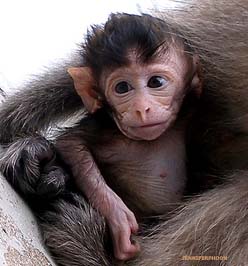Diabetes In Your Pet Monkey – Why It Happens To Captive Monkeys & What You Need To Do About It
Ron Hines DVM PhD





 Is Diabetes Common In Pet Monkeys?
Is Diabetes Common In Pet Monkeys?
Diabetes is the most common disease affecting pet monkeys in the United States. It also occurs in zoo monkey, but diabetes is less of a problem there because the diets of those monkeys are often healthier. Zoo animals also have more space to exercise and they usually are kept in larger groups that keep them active and less centered on eating. It occurs in wild monkeys in Asia and Africa that live adjacent to human population centers when they are fed too many sugar and high calorie snacks by local tourists.
 Which Of The Two Forms Of Diabetes Is Most Common In Monkeys?
Which Of The Two Forms Of Diabetes Is Most Common In Monkeys?
Type II Diabetes
Type II diabetes is also called non-insulin dependent diabetes mellitus (NIDDM). In humans it was also called adult-onset diabetes. Type II diabetes is the form that is far and away the most common form of diabetes seen in monkeys. Early in this type of diabetes, the monkey’s pancreas still produces enough – or more than enough insulin. But the animal’s body has lost the ability to utilize the insulin in processing the blood sugar (glucose) that is in its system. This inability to utilize insulin to process blood sugar is called insulin resistance.
Gestational Diabetes
Just as in humans, pregnant monkeys are at higher risk of becoming diabetic. But this is only if they are already headed down the diabetes road before their pregnancy. Pregnancy puts just enough extra stress on their insulin/glucose energy utilization system to make it fail at this time. Once the stress of pregnancy is over, the monkey’s blood sugar level usually returns to normal. But it will almost certainly become diabetic some time again even without the stress of pregnancy. (ref)
The best way to identify monkeys that are likely to experience gestational diabetes is through a glucose tolerance test that I discuss a bit later. If that test can not be run, persistent high-normal or high blood glucose levels or high A1C/fructosemine levels are a warning that your pet is likely to experience this problem if it becomes pregnant. Monkeys with gestational diabetes can appear perfectly normal. But they experience a high number of stillbirths, difficult births and deaths in labor (dystocia). This is one of the reasons it can be quite dangerous to breed an old monkey for the first time. When gestational diabetes is discovered in a pregnant monkey, the pregnancy can often be saved if the animal is immediately switched to a diet that is lower in sugar, fat and calories.
Type l Diabetes
This form of diabetes is much rarer in monkeys. It occurs when the monkey’s pancreas can no longer produced enough insulin. The pet’s pancreas has several functions. In diabetes l, the cells that normally produce insulin are destroyed by the animal’s own immune system. Read about that here.
When Type I diabetes does occur, it occurs in monkeys of any age that are not necessarily overweight. In humans, it was once called juvenile diabetes. When this rare disease occurs in monkeys, it is managed in the same way as the Type ll form. If it is considered possible in a pet monkey, it can be confirmed with a C-peptide assay with the results compared to a normal monkey of the same species.
Rotavirus
There are a number of simian rotavirus that cause transient diarrhea in monkeys. SRV-1 , YK1 , etc. Monkeys can also develop diarrhea from infection with human rotavirus. (read here) Experimentally, one of these virus, RRV-1, has been found to produce or hasten Type l diabetes in mice. (read here) Whether it could have similar effects on diabetes in monkeys is unknown.
 Is Diabetes More Common In Certain Species Of Monkeys?
Is Diabetes More Common In Certain Species Of Monkeys?
When veterinarians think about type II diabetes in primates, they used to think about rhesus, cynomolgus and other macaques. We certainly see a lot of diabetes in macaques. But they are also the most common monkeys in the large research primate colonies in the US and Europe. With their full-time veterinarian care – we would naturally know more about their health. These research colonies are being managed better now. That, plus the fact that there are more New World monkeys than ever in private homes have changed the statistics of the disease.
It is hard to develop hard numbers regarding the prevalence of diabetes in pet monkeys because they are so scattered. But we know a lot about diabetes statistics in macaque colonies. Over 35% of the monkeys in these colonies have gone on to become diabetic sometime in their lives. In some colonies the incidence has reached 50%.
I know from experience that Type II Diabetes occurs in rhesus, bonnet, pig-tail, Formosan and cynomolgus macaques as well as capuchin monkeys. From the literature, it is evident that sacred and mandrill baboons, tamars, tamarins, monas, bushbay, green vervet monkeys, guenions, squirrel monkeys, chimps, orangs, gorillas and bonobos develop the disease as well. That probably means that provided the proper risk factors, any species of monkey can develop diabetes II. Woolly monkeys have always been a tough species to keep successfully. Gestational diabetes (a form of Diabetes II) and high blood pressure have always been a problem when raising them. Diabetes is very prevalent in pet capuchins – but then there are so many of them around in private hands.
We also see diabetes occasionally in prosimian lemurs as well. But not nearly as often as in true primates. Unlike monkeys, lemurs with diabetic, can usually be managed indefinitely with diet changes and oral glycemic control medications.
 What Are The Risk Factors That Would Make It Likely That My Monkey Will Develop Type II Diabetes?
What Are The Risk Factors That Would Make It Likely That My Monkey Will Develop Type II Diabetes?
Monkeys that are at higher risk of developing Diabetes have many, if not all, of these important things in common. I mentioned them earlier. They are the 10-point life style that applies to the risk factors for humans as well.
1) They are feed too many sugary, starchy and fatty foods by their owners
2) Their total daily food intake is too high
3) They were bottle fed as infants
4) They do not receive enough fiber in their diet
5) They are overweight
6) They live alone or in small groups or two or three
7) They live indoors
8) They do not get enough exercise (a sedentary lifestyle)
9) They are not given enough stimulating activities
10) They are middle-aged
At What Age Does Diabetes Most Commonly Occur In Monkeys?
Just as in humans, it is possible to predispose a monkey to diabetes at a very young with an unhealthy diet or over consumption of food. But the signs of the disease do not generally become apparent until the pet is a mature adult. Basically, the earlier in life the monkey’s weight, blood sugar, triglycerides and cholesterol rise above normal, the earlier in life it will develop type II diabetes. In humans, those are called the pre-diabetic state. In one large rhesus monkey colony , it was found that 30-50% of the animals that were allowed to eat as much monkey chow as they desired, became diabetic at some point in their lives. The earliest ones were about 10 years old at the time – equal to a human of 20. The oldest was 29 years – equal to a human of 75. Based on high blood sugars (over 126mg/dl), 5% were diabetic at 10-14 yrs, 20% at 14-18 years, and 50% when over 26 years old.
 Are There Any Signs I Might Notice That My Monkey Is In The High Risk Group?
Are There Any Signs I Might Notice That My Monkey Is In The High Risk Group?
If your pet monkey lives the Ten-point life style I mentioned earlier, I can assure you that it is in the high-risk group.
Your monkey is also in a higher than normal risk group if:
1) It has had several fasting blood glucose reading of over 80 mg/dl
2) It’s fasting triglycerides level is over 37 mg/dl
3) It’s fasting cholesterol level is over 110 mg/dl
4) It’s high-density lipoprotein (HDL-C) is less than 48 mg/dl
5) It is overweight (healthy wild monkeys are naturally very lean – thin to the human eye).
The sugar metabolism of monkeys in the high risk group needs close scrutiny.
Monkeys, like humans, process sugar abnormally long before they begin to spill sugar into their urine or develop other symptoms of diabetes.
If your female monkey develops recurrent or persistent urinary tract infections, wounds that do not heal, self-mutilation, sudden loss of weight, depression, apathy, miscarriages, stillbirths, uterine infections or any other evidence of chronic disease, it’s urine and blood sugar levels need to be checked as well.
 What Are Some Of The Signs I Might See If My Monkey Does Develop Diabetes?
What Are Some Of The Signs I Might See If My Monkey Does Develop Diabetes?
Many owners do not realize their pet has a problem until it is late in the disease. Diabetes creeps up slowly. By the time symptoms are obvious, they are often due to irreversible destruction in basic body organs due to many months or years of high blood sugar. In monkeys, blood sugar levels tend to be 15-25mg lower than they are in humans in the various stages of diabetes. The tasty, but deadly diets that cause diabetes in monkeys are too high in sugars, carbohydrates and fats. But they are usually deficient in balanced proteins, vitamins, and minerals. So other disease problems usually complicate matters – give a mixed bag of signs.
The first sign a monkey owner often notices is more frequent urination and drinking more. As I mentioned earlier, recurrent urinary infections and urine dribble are also common.Although pre- and early diabetic monkeys are fat, they loose weight as the disease progresses. Sometimes the first signs that alert owners that something is seriously wrong with their pet is general listlessness, apathy for the things it once enjoyed doing (a depressed mood). Late in diabetes, appetite fails and the monkey becomes thin.
Mouth infections and dental problems have booth been related to an underlying diabetes problem. In capuchins, regurgitating and re swallowing their food has been associated with diabetes; although these same signs can occur for many other reasons. Some of these monkeys develop cataracts and vision problems (retinopathies). Others no longer use their tails as they once did – due to diabetes-induced nerve damage (neuropathy). In other pets, the persistent high blood sugar of diabetes damages the animal’s kidneys. Eventually, the depression, listlessness and disinterest in food progress to coma and death.
 What Tests Will My Veterinarian Run?
What Tests Will My Veterinarian Run?
If your veterinarian is suspicious that your monkey might have a diabetic or pre-diabetic problem, the first thing the vet will do is look for sugar in your pet’s urine. The urine sample does not need to be taken at the veterinarian’s office – but it needs to be refrigerated or placed on ice until it arrives there. Sugar in the urine is quite stable for 24 hours, although the glucose level will go down with time if the sample is highly contaminated with bacteria.
If the urine sample is positive for sugar, the veterinarian will want a blood sample. That is something your monkey will not like – but it needs to be done. Giving the pet a ketamine injection to keep it still for the blood draw will not restraining a frightened monkey. Stressing the monkey during blood collection is why published figures on blood sugar level in primates tend to be too high. Bring your monkey to the vets office in a pet carrier still wearing a tethered collar – not on your shoulder. Schedule an appointment when the waiting room is not full of waiting clients, dogs, cats and children. If you use a house call vet, have the monkey caught up before he/she gets there. Be sure a larger monkey has not eaten for 6-8 hours on the day of the visit. If you have marmosets, squirrel monkeys or other monkeys of less than 3 pounds – ask the vet how long you can safely fast the pet. The veterinarian will send the blood sample off to a central testing laboratory. I prefer national labs because their testing machines give more accurate results than smaller, in-office machines.Many things other than diabetes can cause a single blood glucose reading to be moderately higher than normal. The most common ones are stress, fear and agitation (stress hyperglycemia) . This problem can also make mild cases of diabetes appear to be more severe than they actually are and it can give false reading to other tests as well. Monkeys know “when something is up” and begin releasing blood chemicals that raise their blood sugar levels. What is considered to be a normal blood glucose level varies between laboratories and veterinarians. But some normal fasting blood glucose level that are considered normal are: common marmoset, about 126mg/dl (30-150), Capuchins 44-94 (although some report higher), lemurs 127 (55-180), owl monkey 130, rhesus 53-80, cynomolgus 40-123, baboon 80-95, chimpanzee 62-94, capuchins 47-73. If your pet’s fasting blood glucose reading is much above these values, it needs to be retested at a later date. In the USA, figures are given in mg/dl (milligrams per deciliter) if you live outside of the USA; they are given in mmol/l (millimoles/liter), in which case you need to multiply the amount by 18. More data can be found on the ISIS/Species360 website.
 What If, On Several Occasions, My Monkey’s Blood Glucose Level is Higher Than The Values You Gave?
What If, On Several Occasions, My Monkey’s Blood Glucose Level is Higher Than The Values You Gave?
If you find that your monkey’s fasting blood glucose levels are only moderately higher than the ones I gave, several other blood tests need to be run:
An Intravenous Glucose Tolerance Test (IVGTT)
The theory behind this test is to give the monkey’s system a large sudden dose of sugar to handle and see how efficiently the pet deals with it. In humans, the glucose used in this test is given orally. That can be done in monkeys. But when liquefied sugar is offered to monkeys, it is hard to know if all was eaten in an acceptably short period of time. Besides, many monkeys become suspicious and don’t drink it. So the sugar solution is usually give intravenously (0.25 – 0.75 gm/Kg). It is best if the monkey is given a low dose of ketamine or another immobilizing agent to calm it during the glucose injection. This is usually done through the saphenous vein – the long, easily visible vein that runs down the inner side of your monkey’s leg. If the rapid method is used, a blood sample is taken jut before the glucose is injected and a sample taken 30 and 60 minutes later. If the more accurate method is used, a blood sample is collected 5,10,20,30,60 and 120 minutes after the glucose is injected (I just don’t like stressing out the monkey so many times). Then a number, called the K-value is calculated. In normal squirrel monkeys, K values should be around 7.75 +/- 2.84 with peak blood glucose level at 15-30 minutes . In normal cynomolgus monkeys, the K value should be 3.12 +/- 0.48 with blood glucose peaking at 5-30 minutes. (read here)
Immunoreactive Insulin Level (IRI)
Because performing the glucose tolerance test is complicated, some veterinarians rely on another simpler test, fasting blood insulin levels, to confirm diabetes in monkeys or identify monkeys that are in the prediabetic stage of the disease. In one study, apparently normal Rhesus monkeys, had fasting plasma insulin levels of 20-70 µU/ml. While those that were diabetic, or on their way to become diabetic had levels of 100 or higher. In another , normal rhesus monkeys had fasting plasma insulin levels of 123 ± 37, while pre-diabetic and diabetic monkeys had levels as high as 623. John’s Hopkins/U.MD considers fasting plasma insulin of up to 70 µU/ml to be normal in their rhesus monkeys. (read here)
A1C Glycolated (glycated, glycosylated)Hemoglobin & Serum Fructosamine
If you or your veterinarian suspect that catching and holding down your fearful monkey falsely raised its blood sugar value, the A1C test or the serum fructosamine test may clear the question up. (read here)
These are also a good test to see how well you are doing in the long term management of your monkey’s diabetes. The value of these tests are that they reports what the average blood glucose level has been in the pet over the last 120 days or so. Normally , non-diabetic monkeys stay about 5% glycated. The test does not appear to work well in lemurs. Because labs and veterinarians run so few of these tests, it is best to submit the sample from your monkey with one or two samples from healthy monkeys of similar age and species.
Nerve Conduction Studies
Monkeys that have suffered from diabetes for extended periods of time loose nerve function just like humans do. If you have a diabetic monkey that is loosing its normal agility, reluctant to hang by its tail, limping, or loosing bowel or bladder function, nerve conductivity studies can confirm that it is due to diabetes-caused nerve degeneration (diabetic neuropathy). (read here) There is nothing that will repair these damaged nerves, but cage and lifestyle modifications will keep the monkey’s life as pleasant as possible.
 Is Genetics Part Of This Problem?
Is Genetics Part Of This Problem?
Although monkeys sold for pets in the US are more inbred than they should be, there is no real evidence yet that genetics has any part to play in the development of diabetes in pet monkeys as it sometimes does in people. With time, that may no longer prove to be the case.
Bottle-fed Infants And Stressed Mothers
Mother monkeys housed in stressful situations (small cages, incompatible side-by-side groups, etc.) can have hormone surges that lead to abnormal fat metabolism in their babies – a risk factor for later diabetes. (read here) Even if we don’t know if genetics plays a role in diabetes in pet monkeys, we do know that what is fed to baby monkeys from birth probably does influence their susceptibility to diabetes later in life. It also influences their lifelong taste preferences and eating habits.
Birth Control Products
The implantable and injectable birth control products sometimes used in larger monkeys and apes puts them at risk for Type II diabetes. as it does in women and cats. (read here)
What Diabetes Treatments Are Available For Monkeys?
Oral Hypoglycemics Medications
Some monkeys, with early diabetes, can be manged with medicines that are given orally. Not all can. And many will need injections of insulin as time goes by. They work best when the monkey’s body weight is returned to normal with proper diets. They are just as easy to overdose with as the injectable products. If the container of good-tasting medicine is left around where the monkey can drink it, it can be fatal. The standby medication in this group is Glipizide (Glucotrol), although there are a number of similar compounds in this group (sulfonylureas). It works best in monkeys when diabetes is mild and when it is combined with a strict, healthy diet. It has been used successfully to control diabetes in monkeys at 1.25mg/kg given once a day.
Another oral hypoglycemic medication is metformin (Glucophage®). It has been used in rhesus monkeys for short periods to control gestational diabetes. It might have advantages in monkeys that are known to have already developed heart disease or in combination with glipizide when glipizide alone is not keeping blood glucose levels under control. (ref) The pet’s kidney function needs to be adequate to handle metformin and no long term information on its use in monkeys is available. In humans, metformin also helps diabetics to loose weight and seems to keep their triglyceride and cholesterol levels lower.
Before resorting to giving these medications to your monkey, you should see if controlling its diet alone is enough to keep its blood glucose level in the normal range. Although once-a-day dosing is sufficient in people, small monkeys can metabolize drugs at different rates than humans and may need their medication more or less frequently. This means that a slightly wrong dose or missed breakfast can put your monkey into a state of potentially fatal hypoglycemia. (read here) Another drug in this group, tolbutamide (Ornase®), has been used to control blood sugar levels in capuchins . (read here , & here) Medical scientists are always looking for oral alternatives to insulin injections when treating diabetes in humans and most of the products that are in development eventually get tested in monkeys. But I do not know of any veterinarians using these agents to treat pet monkeys.
Injectable Insulins
Unlike dogs and cats, there is very little difference between the insulin human bodies make and the ones monkeys make. So the human insulin’s that pharmacies sell tend to work well in monkeys. As with humans, monkeys on insulin injections need to have their blood sugar level monitored frequently and their insulin doses adjusted. Particularly when they are just beginning their injections or when their situations change.
No matter which insulin is used, it is best to begin at half the calculated required dose – just to be safe. If too much insulin is given, the monkey will go into shock (hypoglycemia). After beginning cautiously, the dose should be slowly adjusted upward depending of the pets glucose level after it has eaten (postprandial blood glucose level). There are a number of insulins on the market. They are sold in rapid acting, short acting, intermediate acting and long acting forms:
NPH Insulins
NPH insulin; also known as Humulin N, Novolin N, Novolin NPH, NPH Lletin II, are intermediate-acting insulins that cover insulin needs for about half a day. It is recommended by some at 0.25-0.5 units/kg per day in monkeys as a starting dose. When given in its 70/30 form it worked well in rhesus monkeys when given at 0.25 IU/kg twice a day.
Porcine (Pig) Insulin
Porcine insulin is still available because it works better than human insulin in dogs and cats. It has been replaced by human NPH insulins in treating people because human insulins are less likely to cause eventual destruction of the product by the patients own body – this may also be true in monkeys. But porcine insulin has controlled diabetes well in monkeys – at least for limited periods of time – when given twice a day. (read here) I would avoid using it in pet monkeys for the same reason it is no longer commonly used in people.
Long Acting Insulins
Long-acting insulins (Ultralente (U), Lantus and Levemir (detemir), etc.) can control blood sugar levels in people for 20-36 hours. They do control blood sugar levels in monkeys – but not for as long a period as they do in humans.
No matter what insulin you and your veterinarian choose to use, your pet’s blood glucose level needs to be checked frequently and its urine needs to be regularly checked for sugar or ketones. A chart also needs to be kept of your pet’s body weigh to be sure things continue to go well. In this way, the insulin dose can be fine-tuned to the monkeys daily needs. These will vary with daily activity level, food type and amount, outdoor or room temperature and stress level. The required dose is likely to creep up with time as the disease progresses.
Fenofibrate
The drug, fenofibrate, has been used experimentally in fat rhesus monkeys. Incidental to its intended use, it was found to also lower their blood insulin levels as well as their triglycerides and bad cholesterol. It is not a drug that will control diabetes in pet monkeys, but in high diabetes risk pets that have failed to loose weight dieting and who have persistently high blood triglycerides levels – the drug might offer some help.
 What Is The Best Way To Give My Monkey His Insulin Shots?
What Is The Best Way To Give My Monkey His Insulin Shots?
First off – you are probably going to get bitten doing this. Read my article on the dangers of monkey bites. If you are uncomfortable with what you read there and the potential risks to your health, you have no business working with monkeys.
As you know, or will soon find out, getting a monkey to cooperate in receiving shots can be quite a challenge. Monkeys are highly intelligent, you won’t outfox one more than once with any particular trick. They are fast as lightening as well. The only way you will succeed in getting your pet to take insulin is if the monkey receives something it really wants in return for letting you give it the shot.
Begin by buying some diabetic injection syringes with needles attached. For small monkeys, use the smallest and shortest gauge of needle available (31-G, 8mm). These needles cause the least pain and they are the least likely to cause damage if the monkey moves. You cannot inject them as quickly as you can with the larger diameter needles – so if your monkey is going to fidget, you may not be able to use them. Most monkeys resent being covered with a towel and will squirm even more and fear the towel the next time you try to use it.
Take one syringe and break off the needle. A week or two before you attempt to give an injection, get the monkey to associate the syringe with a food treat it really likes. I know, I told you not to give treats. It is the flavor of the treat – not its amount – that the monkey is going to think about. It need be no larger than a single raisin. Continue doing this every day until the monkey willingly sits for the syringe procedure.
Many monkeys can be trained in this way to present their arm, leg or tail through a cage for their daily insulin shots. If it won’t give you its arm – try to teach it to lean against the cage as you offer it treats. This technique usually works – most, but not all monkeys will accept it.(ref1, ref2 ) Scientists call this technique, operant conditioning. Watch how it is done in cats on YouTube. Use the same technique to try to get your monkey to cooperate in checking its blood glucose with a meter. Network with experienced monkey owners. If you prick the monkey’s fingers, do not prick on the side that has the finger prints. I prefer pricking their tail – clip off the hair on a small area near the end.
If all else fails, you can roughly judge the effectiveness of the insulin dose by measuring the amount of glucose in your monkey’s urine. This is not an accurate way to plan or keep up with the health of a diabetic monkey – but sometimes it is the only way. (read here) The danger in only doing urine checks is that you will not be warned if you are giving too much insulin and you will not know if you are not giving enough until the monkey’s blood sugar level is above 160-180 mg/dl or so.
When it comes time to load the syringe with insulin, get exact instructions from your pharmacist. Diabetic syringes are often marked in several scales and it is very easy to become confused as to the number of units you are injecting. Once you pick a brand of syringe and needle, stick with that brand. If you change, ask the pharmacist again to show you which mark represents the correct number of units. Overdosing because of syringe confusion is the most common accident when giving insulin.
Hypoglycemia
Hypoglycemia (dangerously low blood sugar level) is the greatest risk when treating diabetic monkeys. Most monkeys do not weigh very much. So very small changes in the amount of diabetic medicines you give will have great effects. This goes for establishing the initial dose and for changes upward in their daily dose. If you utilize a human diabetic specialist or nurse technician that deals with human diabetics, they may recommend dose changes that are to large or too abrupt because they have not dealt with many patients as small as your monkey. Do everything much more gradually as it is generally done in adult or adolescent humans.
Also, do not begin establishing the insulin dose and a major dieting plan at the same time. Cutting back you monkey’s calories will increase the power of the insulin dose or tablet. When you begin the dieting , blood glucose levels need to be checked frequently again because the correct amount of insulin the animal needs – and possibly the frequency – will drop.
 How Long Can My Monkey Be Successfully Treated?
How Long Can My Monkey Be Successfully Treated?
The length of time a diabetic pet monkey can be successfully treated depends entirely on how tightly its blood sugar level can be controlled and at what stage of the disease treatment is begun. With good care, 10-12 additional years is possible.I personally saw dramatic health improvement in my spider monkeys when I eliminated sugary and starchy fruits from their diet.






 Is Diabetes Common In Pet Monkeys?
Is Diabetes Common In Pet Monkeys? Which Of The Two Forms Of Diabetes Is Most Common In Monkeys?
Which Of The Two Forms Of Diabetes Is Most Common In Monkeys? Is Diabetes More Common In Certain Species Of Monkeys?
Is Diabetes More Common In Certain Species Of Monkeys? What Are The Risk Factors That Would Make It Likely That My Monkey Will Develop Type II Diabetes?
What Are The Risk Factors That Would Make It Likely That My Monkey Will Develop Type II Diabetes? Are There Any Signs I Might Notice That My Monkey Is In The High Risk Group?
Are There Any Signs I Might Notice That My Monkey Is In The High Risk Group? What Are Some Of The Signs I Might See If My Monkey Does Develop Diabetes?
What Are Some Of The Signs I Might See If My Monkey Does Develop Diabetes? What Tests Will My Veterinarian Run?
What Tests Will My Veterinarian Run? What If, On Several Occasions, My Monkey’s Blood Glucose Level is Higher Than The Values You Gave?
What If, On Several Occasions, My Monkey’s Blood Glucose Level is Higher Than The Values You Gave? What Is The Best Way To Give My Monkey His Insulin Shots?
What Is The Best Way To Give My Monkey His Insulin Shots?